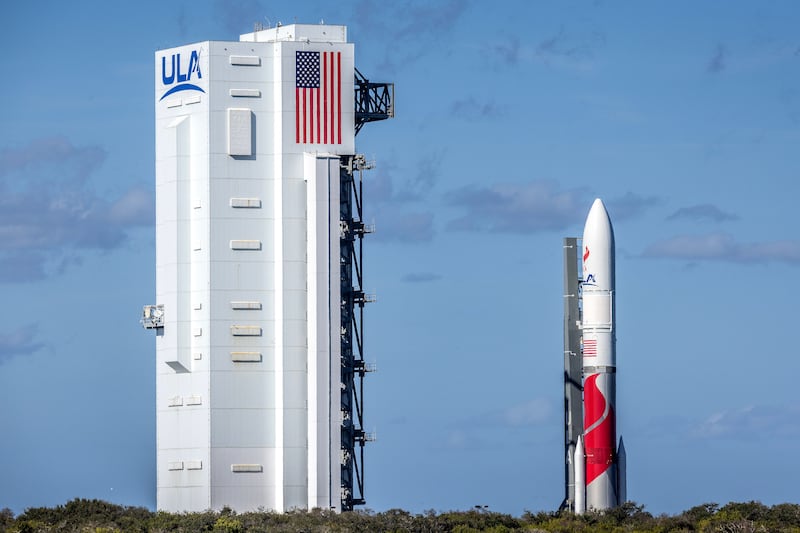A private moon mission that blasted into space on Monday appeared to be in jeopardy after suffering a “critical loss of propellant” and operators said they are considering alternatives for the mission.
After lift-off on Monday, the Peregrine Mission One (PM1) – which carries a piece of technology developed by UK scientists – experienced an “anomaly” that would have prevented the lander from achieving a stable position pointing towards the sun, according to Astrobotic, the US firm behind the project.
While this was fixed, the company established that it was being caused by a failure in the propulsion system, and further investigation revealed the craft was losing propellant.
Across two separate statements, the company said: “We have successfully re-established communications with Peregrine after the known communication blackout. The team’s improvised manoeuvre was successful in reorienting Peregrine’s solar array towards the sun. We are now charging the battery.
Fears and hope before Venezuelan election that could bring rebuilding or ‘a bloodbath’
Judge to question Spain’s prime minister in contentious corruption case
‘People can’t be held back’: Ukrainians flock to Odesa for wartime holidays in the sun
Netanyahu hopes his speech to US Congress will improve his tarnished image in Israel
“The Mission Anomaly Board continues to evaluate the data we’re receiving and is assessing the status of what we believe to be the root of the anomaly: a failure within the propulsion system.
“Unfortunately, it appears the failure within the propulsion system is causing a critical loss of propellant. The team is working to try and stabilise this loss, but given the situation, we have prioritised maximizing the science and data we can capture. We are currently assessing what alternative mission profiles may be feasible at this time.”
The lander carrying Nasa scientific equipment initially launched successfully on the Vulcan Centaur rocket from Cape Canaveral.
Earlier on Monday, the mission blasted off into space, set to become the first private probe to land on the lunar surface.
The spacecraft is now flying solo on its way to the moon, where it will attempt to land on February 23rd.
The Vulcan rocket blasted off from Cape Canaveral in Florida at 7.18am Irish time.
On-board is an instrument known as the Peregrine Ion Trap Mass Spectrometer (PITMS), which was developed in the UK by scientists from The Open University (OU) and the Science and Technology Facilities Council (STFC) RAL Space – the UK’s national space lab – in collaboration with Nasa’s Goddard Space Flight Centre in Washington DC.
Astrobotic chief executive John Thornton said: “Today Peregrine Mission One achieved a number of big milestones.
“Peregrine powered on, acquired a signal with Earth, and is now moving through space on its way to the moon.
“These successes bring us one step closer to seven nations landing on the moon, six of which have never been to the moon before.”
Peregrine is carrying a total of 20 payloads from seven countries and 16 commercial customers.

They include the first lunar surface payloads from the Mexican and German space agencies, and the first lunar payloads from the UK, Hungary and Seychelles.
Among these commercial payloads are items which add a touch of human creativity to space exploration, including a time capsule, a bitcoin and even a music album.
A key component of PITMS, which will explore the moon’s atmosphere by measuring water and other molecules, was developed in the UK with €16.2 million of government funding through the UK’s membership of the European Space Agency.
The data collected will contribute to our understanding of the moon’s potential to provide resources such as water, opening new possibilities for future human presence on the lunar surface.
The UK-built component – called the Exospheric Mass Spectrometer represents the first instrument on the moon that has been built in the UK and in Europe.
As part of the PITMS, the Exospheric Mass Spectrometer allows researchers to study atoms and molecules in a gas.
Science and Technology Secretary Michelle Donelan said: “The Exospheric Mass Spectrometer will be the first science component developed in the UK destined for the lunar surface, marking a historic moment for the UK space industry.
“This significant achievement also lays the groundwork for understanding how to sustain extended human presence on the moon in the future – changing the way humankind interacts with the solar system around us forever.”
Understanding water on the moon is an important part of the Artemis programme, to explore more of the lunar surface than ever before.
Libby Jackson, head of space exploration at the UK Space Agency, said: “The Peregrine Lunar Lander will help pave the way for further exploration of our solar system.
“Witnessing the first instrument from the UK, and indeed Europe, launch to the moon is a hugely exciting moment.
“We are looking forward to seeing Peregrine safely on the surface and the return of important data from PITMS to help unlock the secrets of water on the moon.” – PA




